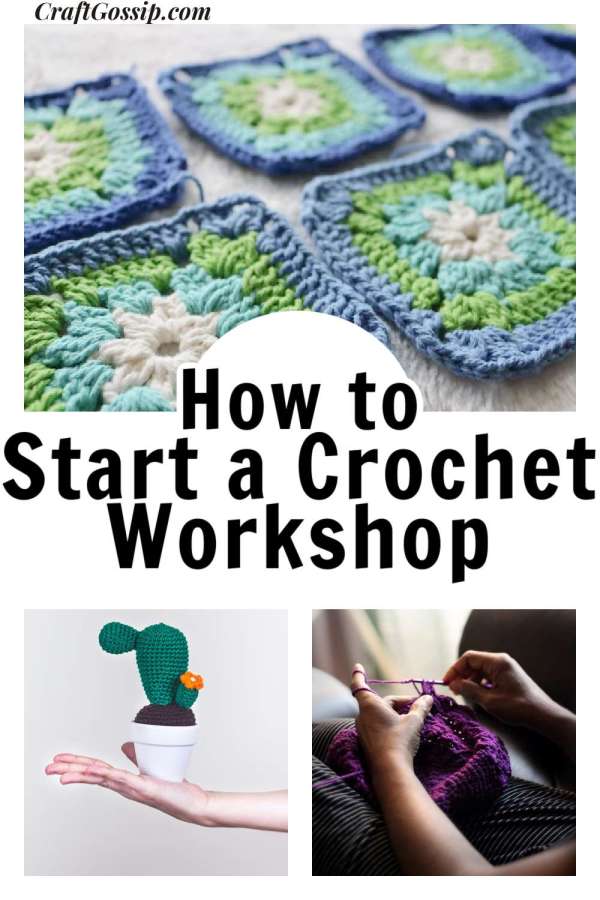
Crocheting is a timeless craft that allows people to create beautiful and functional items using just a hook and some yarn. If you’re passionate about crochet and want to share your skills with others, starting a crochet workshop can be a fulfilling endeavor. Whether you’re a seasoned crocheter or just getting started, here’s a comprehensive guide on how to start your own crochet workshop.
1. Define Your Workshop’s Focus:
Decide on the main theme of your crochet workshop. It could be beginner basics, advanced techniques, specific projects (hats, scarves, blankets), or even crochet for mindfulness and relaxation. Defining your focus will help you tailor your workshop content.
2. Identify Your Target Audience:
Determine who your workshop is intended for. Are you targeting beginners, intermediate crocheters, or those looking to learn specific advanced techniques? Identifying your audience will guide your teaching approach.
3. Plan Your Workshop Curriculum:
Break down the workshop into sessions or lessons. Start with the basics, if applicable, and progress to more advanced techniques. Create a well-structured curriculum that builds upon previous knowledge.
4. Choose a Suitable Venue:
Select a venue that accommodates the number of participants you’re expecting. It could be your home, a community center, local craft store, or even an online platform if you’re hosting virtual workshops.
5. Gather Necessary Supplies:
Ensure you have all the materials needed for your workshop. This includes crochet hooks, yarn of various colors and textures, stitch markers, tapestry needles, and printed instructional materials if necessary.
6. Set Workshop Dates and Times:
Determine the dates and times for your workshops. Consider the availability of your target audience and choose a schedule that works for them.
7. Create Promotional Materials:
Design eye-catching promotional materials such as flyers, social media posts, and online event listings. Clearly communicate the workshop’s details, including date, time, location, cost, and what participants can expect to learn.
8. Registration and Payment:
Decide on a registration process. You can use online registration platforms, social media, or your website. Clearly outline the cost of the workshop and the payment methods you accept.
9. Prepare Workshop Content:
Develop detailed lesson plans for each session. Include step-by-step instructions, visuals, and any helpful tips or tricks. Prepare samples of the techniques or projects participants will learn.
10. Set Up the Workshop Space:
Arrange the workshop space with tables, chairs, and individual workstations. Make sure everyone has access to the necessary supplies and can see your demonstrations clearly.
11. Teach and Interact:
During the workshop, engage with your participants. Demonstrate techniques, provide individual assistance, and answer questions. Make the experience interactive and enjoyable.
12. Foster a Supportive Atmosphere:
Create a welcoming and supportive environment where participants feel comfortable asking questions and sharing their progress. Encourage them to interact with each other as well.
13. Provide Resources:
Offer participants printed handouts or digital resources that summarize the workshop content. This allows them to review what they’ve learned at home.
14. Gather Feedback:
After each workshop, ask participants for feedback. This will help you improve future workshops and tailor your content to meet their needs.
15. Continuously Improve:
As you gain experience, continuously improve your workshop content, teaching methods, and overall experience for participants.
Starting a crochet workshop allows you to share your passion for crochet, connect with fellow crafters, and contribute to the growth of this beloved craft. With careful planning and dedication, you can create a memorable and educational experience for your participants.
How to Price Your Crochet Workshop: Finding the Right Value for Your Craft
Sharing your love for crochet through workshops is not only fulfilling but also a great way to connect with fellow crafters. However, determining the right price for your crochet workshop can be a bit challenging. You want to ensure that your expertise is valued appropriately while making the workshop accessible and attractive to potential participants. Here’s a step-by-step guide to help you price your crochet workshop effectively.
1. Understand Your Costs:
Start by calculating all the expenses associated with your workshop. This includes materials like yarn, crochet hooks, printed handouts, venue rental (if applicable), and any additional supplies or tools needed. Don’t forget to include overhead costs like transportation, advertising, and administration.
2. Determine Your Time Investment:
Consider the time you’ll spend preparing for the workshop, creating lesson plans, setting up the venue, teaching, and interacting with participants. Your time is valuable, so factor in an hourly rate that reflects your expertise.
3. Research Similar Workshops:
Look into crochet workshops offered by other instructors in your area or online. This will give you an idea of the price range for similar workshops and help you position your offering competitively.
4. Define Your Workshop’s Unique Value:
Highlight what sets your workshop apart. Do you have years of experience, unique techniques, or specialized projects that participants won’t find elsewhere? Your unique value can justify a higher price point.
5. Consider the Market Demand:
Gauge the demand for crochet workshops in your area. If there’s high demand and limited availability, you may be able to charge a premium. Conversely, if the market is saturated, you might need to adjust your pricing strategy.
6. Evaluate Your Expertise:
Your level of expertise and reputation in the crochet community play a significant role in determining your workshop’s value. If you’re well-known for your skill and knowledge, participants may be willing to pay more.
7. Calculate a Per-Participant Fee:
Divide your total costs and time investment by the number of participants you anticipate. This will give you a baseline per-participant fee that covers your expenses and pays you for your time.
8. Add a Profit Margin:
Don’t forget to factor in a profit margin. Your expertise and time deserve compensation beyond covering costs. Add a percentage to your per-participant fee to ensure you’re appropriately compensated for your efforts.
9. Offer Different Pricing Tiers:
Consider offering different pricing tiers to cater to various participants. For example, you could offer an early-bird rate for those who register early or a discounted rate for students. This allows you to accommodate different budgets while still valuing your expertise.
10. Factor in Materials and Takeaways:
If your workshop includes materials and takeaways like printed handouts, patterns, or finished projects, be sure to include their costs in your pricing.
11. Test and Adjust:
As you start offering workshops, pay attention to participants’ feedback and their willingness to pay. If you find that your workshops consistently fill up quickly or that participants are eager to sign up, you might consider gradually increasing your prices.
12. Communicate Your Value:
When promoting your workshop, clearly communicate the value participants will receive. Highlight what they’ll learn, the unique techniques they’ll master, and the projects they’ll create.
Pricing your crochet workshop involves finding a balance between covering your costs, valuing your time and expertise, and attracting participants. Remember that it’s okay to adjust your pricing strategy as you gain experience and a better understanding of your market. By carefully considering your expenses, expertise, and the unique value you offer, you can set a fair and attractive price for your crochet workshop that benefits both you and your participants.
Craft Workshop Insurance: Protecting Your Passion and Participants
Craft workshops offer a unique opportunity for individuals to share their creative skills and connect with like-minded enthusiasts. Whether you’re teaching painting, pottery, soap making, or any other craft, it’s important to recognize the potential risks involved and take steps to protect yourself, your business, and your participants. This article will guide you through the essential insurance requirements for running a craft workshop.
Understanding the Risks:
Craft workshops involve hands-on activities, which can lead to accidents or injuries. Participants might accidentally injure themselves, damage property, or experience adverse reactions to materials. Additionally, there’s a risk of claims arising from dissatisfaction with the workshop content or outcomes.
Types of Insurance for Craft Workshops:
To mitigate these risks, consider the following types of insurance coverage:
General Liability Insurance:
General liability insurance is the foundation of protection for craft workshops. It covers claims for bodily injury or property damage that might occur during your workshop. For instance, if a participant trips and falls, injuring themselves, or if a participant’s property is damaged, this insurance can help cover legal expenses and medical costs.
Professional Liability Insurance:
Also known as errors and omissions insurance, professional liability insurance safeguards you against claims related to your professional services. If a participant is dissatisfied with the quality of instruction or the outcomes of the workshop, this insurance can provide coverage.
Property Insurance:
If you own a workshop space or rent equipment for your sessions, property insurance can cover damage to your tools, materials, or the venue itself due to incidents like fire, theft, or vandalism.
Business Interruption Insurance:
In case of unexpected events that force you to cancel or postpone a workshop, business interruption insurance can help cover the financial losses resulting from the interruption.
Considerations When Choosing Insurance:
When selecting insurance for your craft workshop, keep these factors in mind:
Coverage Limits: Ensure that the coverage limits of your insurance policies are adequate to protect your assets and potential liabilities.
Participant Age: If you work with minors, you might need additional coverage or waivers to address the unique risks associated with underage participants.
Location: If you host workshops in different locations, make sure your insurance covers you in all those spaces.
Materials and Products: If you sell craft materials or products as part of your workshop, you might need product liability insurance to cover claims related to their use.
Steps to Obtain Insurance:
Research Providers: Look for insurance companies that specialize in providing coverage for craft-related activities or small businesses.
Evaluate Coverage: Discuss your workshop’s specifics with insurance agents to ensure you’re getting the coverage you need.
Compare Quotes: Obtain quotes from multiple insurers to find the most suitable coverage at a competitive price.
Read Policy Details: Carefully read and understand the policy terms, conditions, and exclusions before finalizing your insurance purchase.




Leave a Reply